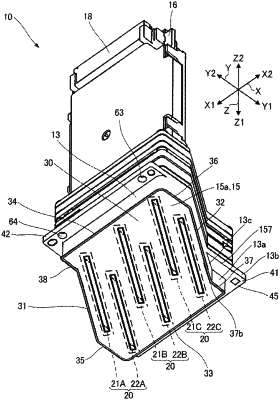| CPC B41J 2/155 (2013.01) [B41J 2/1433 (2013.01); B41J 2002/14491 (2013.01)] | 13 Claims |

|
1. A liquid ejecting head that has an ejection surface configured to eject a liquid and is arranged in a first direction to form a line head, the liquid ejecting head comprising:
an upper surface opposite from the ejection surface; and
an electrical coupling portion disposed to be overlapped with a first end portion of the upper surface, the first end portion being located at an end area of the upper surface toward a second direction orthogonal to the first direction when the upper surface is viewed in a normal direction of the upper surface, wherein
when the upper surface is viewed in the normal direction of the upper surface, an outer shape of the upper surface has:
a first edge and a second edge extending along a third direction inclined with respect to the first direction and separated from each other in the first direction;
a third edge disposed at the first end portion and extending along the first direction; and
a fourth edge disposed at a second end portion opposite from the first end portion in the second direction and extending along the first direction,
when the upper surface is viewed in the normal direction of the upper surface, the upper surface is not overlapped with an acute-angled portion of a virtual parallelogram having a first virtual side contacting the first edge and extending along the third direction, a second virtual side contacting the second edge and extending along the third direction, a third virtual side contacting the third edge and extending along the first direction, and a fourth virtual side contacting the fourth edge and extending along the first direction, and projects beyond an obtuse-angled portion of the virtual parallelogram in the first direction, and
the electrical coupling portion projects beyond the first virtual side in the first direction.
|